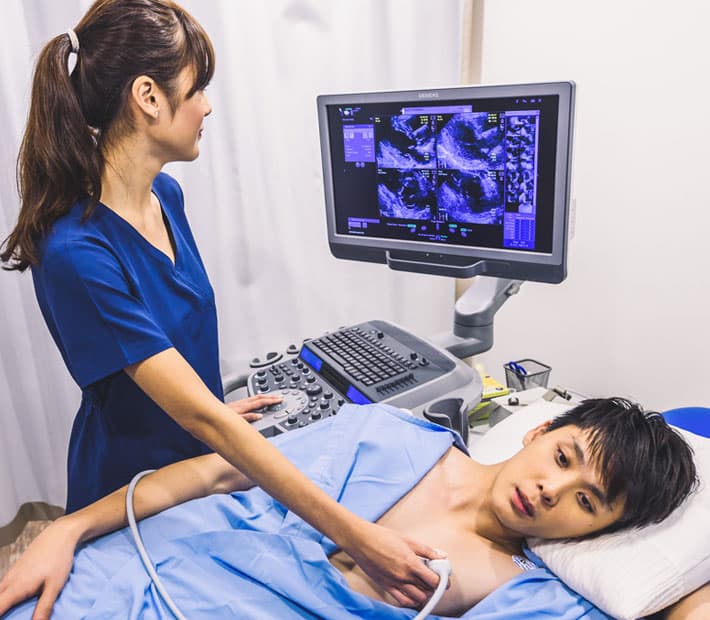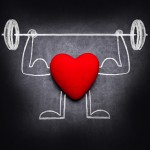EXERCISE STRESS ECHOCARDIOGRAPHY (ESE) in Singapore


Exercise stress echocardiography (ESE) is a specialised procedure that utilises exercise stress to assess how well your heart is functioning, including its ability to show blockages. ESE can help detect and diagnose various heart conditions, including coronary artery disease and valvular heart disease.
Exercise stress echocardiography test in Singapore is widely available and can be done at hospitals and specialised cardiology clinics such as The Harley Street Heart and Vascular Centre. In fact, you may even proceed to book an appointment for a medical consultation with one of our cardiologists or contact us for further details to schedule your ESE test.
What is Exercise Stress Echocardiography (ESE)?
Exercise stress echocardiography, or ESE, is a diagnostic test that combines exercise stress testing with echocardiography. It is used to check the heart's response to physical activity and to assess the presence and severity of coronary artery disease (CAD).
During the day of the test, the patient is subjected to controlled exercise, such as on a treadmill or a stationary bike. Their heart rate, blood pressure, and symptoms are monitored. At the same time, echocardiographic images of the heart are taken using ultrasound technology.
The echocardiogram allows the healthcare provider to visualise the heart's structures, such as the chambers, valves, and blood flow patterns at rest and during exercise. If there is a narrowing or blockage in the coronary arteries, the heart muscle may not receive enough blood and oxygen during exercise, leading to abnormal changes in echocardiogram images or symptoms such as chest pain and shortness of breath.
By comparing the echocardiogram images taken during rest and exercise, the healthcare provider can check the heart's response to physical exertion and determine any compromise in blood flow to the heart muscle. This information helps diagnose and manage CAD and guides the selection of treatment options such as medication, angioplasty, or bypass surgery.
What Is the Purpose of Exercise Stress Echocardiography?
Exercise stress echocardiography aims to assess how well your heart functions under stress. It is performed to test the presence of abnormalities in the heart muscle, blood vessels, and blood flow.
What Happens During an Exercise Stress Echocardiography Test?
During an echocardiography stress test, you will be asked to walk or run on a treadmill while connected to an electrocardiogram (ECG) machine. Electrodes will be placed on your chest to record your heart rhythm and electrical activity. A technician will also place a small transducer on your chest, which emits sound waves to capture ultrasound images of your heart. These sound waves bounce off the heart structures, creating images that assess the heart's health. A pressure cuff will also be placed around your arm to monitor your blood pressure throughout the test, ensuring a comprehensive evaluation of your cardiovascular response to physical exertion.
How Long Does an Exercise Stress Echocardiography Test Take?
An exercise stress echocardiography test typically takes around 45-60 minutes to complete, including the exercise part and the time needed to capture images of your heart.
Why Is Exercise Stress Echocardiography Performed?
An echo stress test is performed to assess the cardiovascular health of individuals. By combining exercise with echocardiography, this test provides valuable insights into the functioning of the heart under stress.
What Conditions Can Exercise Stress Echocardiography Help Diagnose?
Normally, exercise stress echocardiography can help diagnose various heart conditions, including coronary artery disease, valvular heart disease, and myocardial abnormalities. It is particularly useful in evaluating the presence of coronary artery disease, which is a condition that affects the blood supply to the heart.
What Are the Benefits of Exercise Stress Echocardiography Over Other Tests?
Exercise stress echocardiography offers several benefits over other diagnostic tests. It allows for the assessment of both the heart's structure and functions. Additionally, it provides real-time images of the heart throughout the test, allowing for immediate evaluation of any abnormalities. Moreover, exercise stress echocardiography is a non-invasive procedure and does not involve radiation or contrast agents.
Are There Any Risks or Side Effects Associated With Exercise Stress Echocardiography?
Exercise stress echocardiography is generally considered safe and well-tolerated. But, as with any exercise or stress test, there is a small risk of complications such as chest pain, irregular heart rhythm, or shortness of breath. These risks are monitored by the medical staff performing the test.
How to Prepare for an Exercise Stress Echocardiography Test?
To prepare for an exercise stress echocardiography test atThe Harley Street Heart & Vascular Centre in Singapore, start by scheduling an appointment and discussing your medical history. Fast as instructed, wear comfortable exercise attire and suitable shoes. Follow medication guidelines from your doctor. Stay hydrated, but avoid caffeine on test day. Familiarise yourself with the exercise involved and ensure you're ready. Plan for a short recovery period post-test, and expect to discuss results and any necessary follow-up steps with your healthcare provider.
It is advisable to lie on your left side if required during the ultrasound part of the procedure. This position helps optimise the images captured of your heart. Patients may undergo a treadmill exercise as part of their treadmill test or treadmill stress test, where they walk or run to increase their heart rate under monitored conditions. This physical exertion is essential for assessing the heart's response to increased workload.
What Should I Avoid Before the Test?
Before the test, avoiding consuming heavy meals or large amounts of caffeine is advisable, as these can affect the test results. It is also essential to refrain from smoking or using any nicotine products before the test. Alcohol consumption should be avoided, too.
What Should I Wear During the Test?
When getting ready for the ESE test, wearing comfortable clothing and a pair of sturdy, well-fitting shoes suitable for exercise is recommended. Avoid wearing jewellery or accessories that could disrupt the test, and refrain from using lotions or creams on your skin on the test day.
Do I Need to Stop Any Medications Before the Test?
You must inform your healthcare provider about all the medications you are currently taking. Depending on the medication, your healthcare provider may tell you to stop taking certain medications before the test.
What to Expect During an Exercise Stress Echocardiography Test?
During an ESE test at The Harley Street Heart & Vascular Centre in Singapore, you can expect to engage in physical activity on a treadmill or stationary bike. At the same time, your heart's function is monitored through ultrasound imaging. This procedure helps our cardiac experts assess your heart's response to exercise, providing valuable insights into its health and potential issues. The safe, non-invasive test offers essential information about your cardiovascular well-being.
For individuals unable to perform physical tests, a pharmacological stress method simulates exercise's effects on the heart, providing an alternative means to assess cardiac function under stress.
What Will the Technician Do During the Test?
A technician will closely monitor your heart rate, blood pressure, and ECG readings during the test. They will also guide you through the exercise portion, ensuring it is performed safely and effectively.
What Should I Do During the Test?
During the test, you will be instructed to perform exercise on a treadmill. It is important to follow the instructions provided by the technician and to exercise to the best of your ability, gradually increasing the intensity.
Will the Test Be Painful or Uncomfortable?
The test should not be painful, although you may experience some physical exertion and fatigue during the exercise. Communicating any discomfort or symptoms you may experience during the test to the medical staff is important.
Understanding the ESE Test Results
Exercise stress echocardiography is a valuable cardiac test that provides insights into your heart's health. If the test results are normal, your heart muscle, blood vessels, and blood flow under stress exhibit no significant abnormalities.
On the other hand, if the ESE test results are abnormal, this indicates the potential presence of certain heart abnormalities or conditions.
What Does It Mean if the Test Results Are Normal?
If the test results are normal, it indicates no significant abnormalities in the heart muscle, blood vessels, or blood flow under stress. However, it is important to note that ESE cannot completely rule out the presence of heart disease.
What Does It Mean if the Test Results Are Abnormal?
If the test results are abnormal, it suggests the presence of certain abnormalities or conditions in the heart. This may include reduced blood flow to the heart muscle, abnormal heart rhythms, or other signs of heart disease.
Will I Need Further Testing if the Results Are Abnormal?
If the results of the exercise stress echocardiography test are abnormal, further testing may be required to confirm the diagnosis and determine the appropriate treatment plan. This may include additional imaging tests, such as a coronary angiogram, or further evaluation by a cardiologist.
Frequently Asked Questions About ESE
Welcome to our Frequently Asked Questions (FAQ) section about exercise stress echocardiography (ESE) at The Harley Street Heart & Vascular Centre in Singapore. If you're seeking comprehensive information about our cardiac test service, specifically the exercise stress echocardiography, you've come to the right place.
Does Stress Echo Show Blockages?
A stress echo, or exercise stress echocardiography (ESE) test, offered at The Harley Street Heart & Vascular Centre in Singapore, is a valuable cardiac assessment method that can potentially reveal blockages in the heart.
By combining echocardiography with physical stress, this procedure helps detect areas of reduced blood flow to the heart muscles, which could indicate the presence of blockages or narrowed arteries. Through this non-invasive test, individuals can gain essential insights into their heart's health, enabling timely intervention and appropriate care if any issues are identified.
How Long Does an Exercise Stress Echocardiogram Take?
The duration of an exercise stress echocardiogram can vary but typically takes around 45 minutes to an hour to complete. This cardiac test involves exercising on a treadmill or stationary bike while undergoing echocardiography to assess how your heart responds to physical activity. The procedure's length can be influenced by factors such as the patient's fitness level, heart condition, and the time needed for the heart to reach the target rate.
How Much Does It Cost for an ESE Test in Singapore?
The exercise stress echocardiography test in Singapore costs in the region of $450 – $1000. Book an appointment today for this cardiac test and prioritise your well-being.
How Accurate Is Exercise Stress Echocardiogram?
The accuracy of an exercise stress echocardiogram (ESE) depends on various factors, including the quality of the equipment, the expertise of the healthcare professionals administering the test, and the individual patient's characteristics. Generally, ESE is considered a reliable method for detecting abnormalities in the heart's function during stress. However, like any medical test, there can be false positives or false negatives. It's important to discuss the results with your healthcare provider to get a comprehensive understanding of your heart's health.
What Is the Difference Between Exercise Stress and Stress Echo?
Exercise stress and stress echo are both cardiac tests, but they differ in their approach. Normally, the exercise stress involves physical exertion on a treadmill or stationary bike to evaluate the heart's response to an increased workload. On the other hand, stress echo combines exercise with echocardiography, using ultrasound to create images of the heart's structure and function before and after exercise. This provides a more comprehensive assessment of cardiac health, helping to identify any potential issues related to blood flow or heart function.


